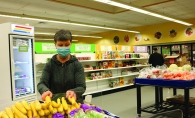Have you ever been part of a holiday food drive? Maybe you donated some noodles or cans of soup, or helped stock the shelves at a local food pantry. During the winter holidays, food shelves experience a surge of giving. But for Plymouth families who are struggling to make ends meet, hunger is a year-round concern.
“Food shelves get a lot of support in November and December,” says Liz Erstad-Hicks, community engagement manager at Interfaith Outreach & Community Partners, a Plymouth nonprofit with a successful food shelf of its own. “Then we kind of lose that support in January, February and March.” Spring food donations are extra important, Erstad-Hicks says: They help restock shelves before summer vacation, when kids and families lose the support of school-sponsored breakfast and lunch programs.
It’s no surprise, then, that Minnesota FoodShare, a Minneapolis nonprofit, organizes the state’s largest food drive during—you guessed it—springtime! FoodShare runs a media blitz for its March campaign, encouraging givers across Minnesota to donate products and funds to their local food shelves.
“It’s a great time to give,” says Erstad-Hicks, whose shelf at IOCP serves more than 900 families every month. “Our food shelf is run and managed by amazing community members who share their time—they’re serving on all levels to make that possible.”
So what are you waiting for? This March, get involved with an existing food drive—through your faith community, your book club or your kids’ school—or be inspired to start your own. Here are some tips from our local experts for organizing a seamless, successful drive:
• Connect with a food shelf in your community. Before you start raising food and funds, decide where your donations are headed, says IOCP’s Erstad-Hicks. “Learn about their needs. There are some items that we really struggle to keep on the shelves,” like ethnic cooking ingredients and healthy snacks, for example.
• Make giving easy. “I wanted to make a bigger impact and get more people involved,” remembers pastor Randy Stensgard, whose congregation at Plymouth Covenant Church led one of the community’s biggest drives in 2013. Stensgard surprised his flock one Sunday morning when he finished his sermon early and sent everyone to the grocery store with a list of needed items for IOCP. “They had no idea what was going to happen,” he says with a chuckle. “People bought 10 times more food than they would normally give.” By setting aside time just for shopping, Stensgard helped his congregation overcome one of the major barriers to giving: finding the time. Even without hundreds of churchgoers at your fingertips, use that sense of convenience (“Hey, book club members—let’s take a 15-minute break to do some shopping for the food shelf”) to motivate friends and family.
• Don’t stop with food. “Consider a fund component to your drive, in addition to food,” Erstad-Hicks says. “Food shelves can actually purchase food through the local food bank, Second Harvest Heartland, and we have great purchasing power. We can get a lot more bang for your buck!” For those friends and family members who can never remember their bag of groceries on donation day, giving a few dollars (or more) can go a long way.
• Branch out. If you’re working with a small cohort on your food drive—your softball team or your department at work, for example—consider other groups who might want to team up. “Make sure you’re getting the word out more broadly,” Erstad-Hicks says. “Engage all parts of your community.” Hang an extra flyer in your office kitchen, or advertise in your neighborhood’s newsletter. Include a quick list of needed items, a drop-off spot and a deadline. And, presto! You’ve got yourself a food drive.
• Have fun. IOCP’s community donors show their artistic sides during the March campaign, with an opportunity called Donation Creation. “We challenge groups to build a sculpture [with the food they raise],” Erstad-Hicks says. “We let people vote on their favorites on our website, and it draws attention to the hard work these people do.” Stensgard agrees that fun is a key ingredient to any successful drive. “It’s such a tangible thing people do,” he says. “The families who participated in our drive had such joy on their faces, to be able to make an impact.”









